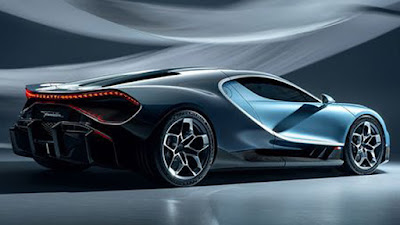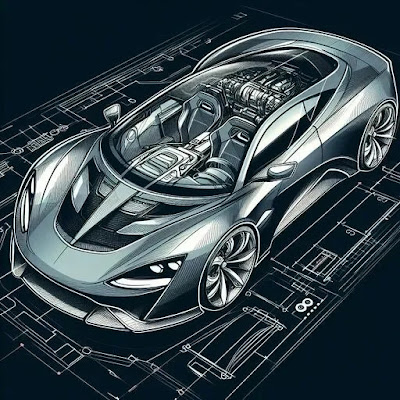NEW ICON - After a long and eagerly anticipated wait, Bugatti Automobiles has finally unveiled the new Bugatti Tourbillon, the much-anticipated successor to the Bugatti Chiron. This groundbreaking release on June 21, 2024, marks a significant milestone for Bugatti, now under the stewardship of Mate Rimac. The Bugatti Tourbillon, stands as the first new Bugatti hypercar of this new era, priced at a staggering $4.1 million, or approximately Rp. 67.4 billion.
 |
| The Bugatti Tourbillon, under Mate Rimac's leadership, marks a significant milestone as Bugatti's first hybrid hypercar. (Picture from: GridOto) |
The Bugatti Tourbillon is not just a new hypercar; it represents a historic first for Bugatti with its incorporation of hybrid technology. "The development of the Bugatti Tourbillon was guided by every step of Bugatti history and the words of Ettore Bugatti himself," remarked Mate Rimac, the Chief Executive Officer of Bugatti. Rimac emphasized the guiding philosophy of Bugatti's founder, Ettore Bugatti, whose mantra, "if you can compare it, it is no longer a Bugatti" and "nothing is too beautiful," was instrumental in crafting this hyper sports car for a new era.
 |
| The Bugatti Tourbillon features a distinctive design that is instantly recognizable as a Bugatti. (Picture from: Voi.id) |
The Bugatti Tourbillon boasts a distinctive design that is immediately recognizable as a Bugatti. As highlighted on the manufacturer's official website, the design embraces the philosophy of "Form Follows Performance," blending 115 years of Bugatti's DNA into a new and exciting era. The design of the Tourbillon is an evolution of Bugatti's design language seen in the Veyron and Chiron, drawing inspiration from historic Bugatti cars such as the Type 57SC Atlantic and Type 35, yet pushing the envelope with more aggressive and aerodynamic aesthetics.
 |
| The Bugatti Tourbillon's design embraces the "Form Follows Performance" philosophy, blending 115 years of Bugatti's DNA into a new and exciting era. (Picture from: Voi.id) |
Despite its new proportions, the essence of Bugatti remains unmistakable. The Tourbillon is crafted to be timeless while prioritizing performance. Each detail is meticulously refined to balance aerodynamic and thermodynamic performance, true to Bugatti's design heritage. The interior of the Tourbillon continues this tradition with a beautifully detailed cabin designed to stimulate the senses, and features a selection of luxurious materials including titanium, wood, cashmere, and sapphire, each chosen to exude unparalleled excellence.
 |
| The Tourbillon's interior features luxurious materials like titanium, wood, cashmere, and sapphire, chosen to exude excellence and stimulate the senses. (Picture from: GridOto) |
The most transformative aspect of the Bugatti Tourbillon is its engine and hybrid drive system. Departing from the Ferdinand Piech era, the Tourbillon replaces the iconic 8,000 cc W16 quad-turbo engine with a normally aspirated V16 engine boasting a capacity of 8,300 cc. This V16 engine, developed in collaboration with Cosworth, generates an impressive 986 horsepower and 900 Nm of torque, allowing the car to accelerate from 0-100 km/h in just 2 seconds.
 |
| The Bugatti Tourbillon remains lightweight thanks to its advanced monocoque structure made from aviation-grade carbon composite material. (Picture from: Voi.id) |
The V16 engine's immense power is complemented by three electric motors that drive the front and rear wheels. The front electric motors each deliver 670 hp and up to 3,000 Nm of torque. Additionally, there is a rear wheel drive motor positioned between the engine and transmission that provides 335 hp and 240 Nm of torque. Altogether, the Bugatti Tourbillon achieves a combined power output of 1,775 hp and can reach speeds of up to 445 km/h.
The Bugatti Tourbillon is not only powerful but also technologically advanced. Its instant power delivery and optimal torque flexibility make it the most dynamic Bugatti ever created. The car can operate in hybrid or fully electric mode, offering the convenience of entering electric vehicle zones in urban areas with ease.
 |
| The Bugatti Tourbillon, powered by an 8,300 cc naturally-aspirated V16 engine developed with Cosworth, generates 986 horsepower and 900 Nm of torque, accelerating from 0-100 km/h in just 2 seconds. (Picture from: GridOto) |
Despite housing a battery and electric motor, the Bugatti Tourbillon remains lightweight thanks to its advanced monocoque structure made from aviation-grade carbon composite material. This material is ingeniously designed to integrate the battery casing and front air intake as structural components, optimizing every element to ensure minimum weight and maximum performance.
 Unsurprisingly, the Bugatti Tourbillon represents the pinnacle of performance in the Bugatti lineup. However, this extraordinary hypercar is currently undergoing further testing, with customer deliveries scheduled to begin in 2026. Only 250 units will be available for the initial release, making the Tourbillon an exclusive and highly coveted masterpiece. As we eagerly await the arrival of this groundbreaking vehicle, one thing is certain: the Bugatti Tourbillon is set to redefine the future of hypercars. *** [EKA | FROM VARIOUS SOURCES | BUGATTI | CARSCOOPS | AUTOCAR | AUTOEXPRESS | MOTORAUTHORITY ]
Unsurprisingly, the Bugatti Tourbillon represents the pinnacle of performance in the Bugatti lineup. However, this extraordinary hypercar is currently undergoing further testing, with customer deliveries scheduled to begin in 2026. Only 250 units will be available for the initial release, making the Tourbillon an exclusive and highly coveted masterpiece. As we eagerly await the arrival of this groundbreaking vehicle, one thing is certain: the Bugatti Tourbillon is set to redefine the future of hypercars. *** [EKA | FROM VARIOUS SOURCES | BUGATTI | CARSCOOPS | AUTOCAR | AUTOEXPRESS | MOTORAUTHORITY ]Note: This blog can be accessed via your smart phone


































